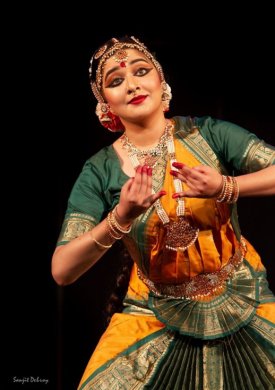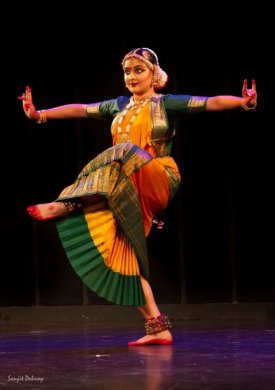
|   |

|   |
Nrityaswaroopa - Kalakshetra bani at its best - A.M. Hari Shankar e-mail: hshankar252@gmail.com Photos: Sanjit Debroy February 23, 2020 Delhi has always been an arable land for the growth of art and artistes for many decades. But, it's a wearisome task for them to gain acceptance among the culturally diversified society, especially when it comes to South Indian classical dance. Leading gurus have been taking sincere efforts in promoting and popularizing them to the assiduous young audiences of Delhi, with experimenting within their traditions so that the nescience of understanding and appreciating would be alleviated among them. Also, sculpting the next generation to take up art seriously remains a challenge to the whole art fraternity. A ray of hope was seen, where multifaceted Bharatanatyam dancer, teacher, author and researcher Guru Jayalakshmi Eshwar, who has been the torchbearer for many leading dancers of the current generation, presented one of her senior disciples, Anannya Chatterjee in a recent Bharatanatyam recital organized by Abhinaya Centre for Bharatanatyam, staged at India Habitat Centre, New Delhi. The evening titled 'Nrityaswaroopa - explorations within the tradition' stood unique for the strict adherence to the Kalakshetra bani of Bharatanatyam. The recital was divided into two segments, the first half exhibited traditional margam compositions and the other half showcased some of the choreographic works of her guru's repertoire. Anannya had one of the best support as accompanying artists led by Jayalakshmi on nattuvangam, vocal by Sudha Raghuraman with Tanjavur Keshavan and Raghuraman Govindarajan on mridangam and flute respectively. Anannya gave a stunning start with an Alarippu set to tisra eka talam which was sung along with Thiruppugazh which created a special ambience of both devotion and the technical intricacies with Sudha, not losing the melody amidst the fine rendering of sollus by her guru. She impressed her audience with strong command over the rhythm and grace on her face despite the robust footwork. It was followed by Jatiswaram in ragam Kalyani and rupaka talam, choreographed by Rukmini Devi Arundale in which the dancer completely explored the various possibilities of nritta aspects of the item. The style of rendering an adavu, the long stretched arms, placing of toes, all showcased the aesthetic beauty of the bani. One could clearly recognise her imbibing of the dancing style of her guru even in her slight gestures, twists and turns. 

The central piece, the Varnam, a composition of Tanjore Ponnaiah Pillai was based on bhakti shringara set in Sankarabharanam and talam adi. The nayika yearning for her benevolent Lord Shiva asks, "Why this anger and indifference to me...My longing for you is so severe that even the cold breeze feels like the hissing breath of the serpent.. I can't bear the singing of birds when I am in this affliction of viraham (separation)". Praising him for trapping the mighty Ganga on his matted hair, the nayika concludes with praying to Brihadeeshwara to have mercy on her. The episodes of exasperation she feels of even not enjoying nature's bliss due to her separation were done with exceptional finesse, proving Anannya's command over not only the technical but also the emotive aspects of the dance. The elegant choreography with captivating metric jatis with delightful abhinaya was a perfect blend of both nritta and abhinaya. The mellifluous vocal support with soothing rendition of flute added more glory to the performance. She then presented Varuna Kautvam, one of the navasandhi kautvams performed earlier in temples to propitiate the deities of 9 directions or sandhis (Brahma being the ninth in the centre where the 8 sandhis meet) in praise of Varuna, the god of oceans and deity of the West. In this composition by the Tanjore Quartet set in Varali and adi, the dancer depicted Lord Varuna - who is often prayed to for prosperity - as riding on a crocodile (makara) and holding the serpent and the noose (pasa) and a vessel of gems. The portrayal of riding on the crocodile over the oceans, and aptly spaced theermanams was really delightful. The Marathi composition 'Kaamchatura' by Serfoji Maharaj in raag Lavangi is a ninda stuti which indirectly depicts and praises Lord Shiva. The nayika Parvati who is separated and longing for her beloved was, hit mistakenly by Kamadeva's love arrow thinking her to be Shiva. Parvati says, 'Oh, clever Cupid, I'm not Shiva. This is not Shiva's matted hair but my long hair untangled due to pain; this is not the moon which resides in Shiva's hair but a white flower. I am not neelakanta, this is kasturi on my neck. This is not the white ashes or vibhooti but due to my yearning for him, my body has become ashen.' The subtle expressions of the dancer well portrayed the actual plot of the item. Anannya concluded her recital with a Thillana set in raagam Garudadhwani composed by Dr. M Balamuralikrishna exploring various complex rhythmic patterns and thunderous playing of mridangam brought an impressive conclusion to a very delightful evening. Apart from a confusion of whether thillana would be followed by mangalam as announced, the event was well organized and also was kept in time. With even more profound research under her guru, Anannya looks to be a dancer with a promising future. Delhi based A.M. Hari Shankar is currently working as an Editor in a leading publishing company by profession, a percussionist and an art enthusiast by passion. |